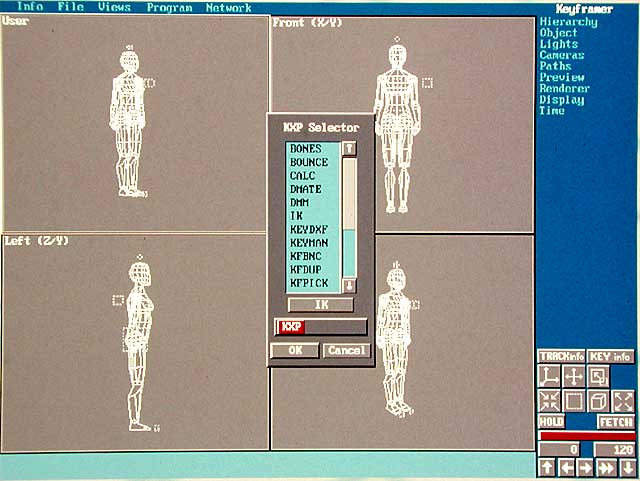Greetings September!
I am not a designer so i never had much hopes on creating glamorous and perfected pictures, doing it in some style with an sleek and clean approach. I`ve graduated in fine arts, took painting classes and was a child of a sculptor (my mother) and a painter (my father). Perhaps that is why since i began working with 3d in those early computers were subdividing a model`s geometry could be cpu torture.

This was my first contact to a 3d graphics package, the first 3d Studio (dos)
There was no Ambient Occlusion or Global Illumination (both tools today provide a more accurate light scattering=more real cg). So i ended up making clean, expressive shapes with a very low polygon look. I just wanted to be able to tell a story without worrying with the realistic aspect of it. Back then many of my interests revolved about Japanese anime and that was when i realized a great part of their expression is simplification, stylization and investing on storytelling. That was the comfortable side i was trying to work on. So when having to revisit Alice (my old college comic book obsession), i knew that some decisions had to be taken. It should look and feel real to my drawing expression but also be faithful to its computer graphics nature.
Rendering. courtesy of Bill Altenburg
So i had here a huge challenge, re adapting the story of 19th century little girl, introduce an alien world and have some visual cohesion between the two. The easiest guess is to paint a Steampunk laye in the nooks and crannies of the Vorpal Spaceship. That could work but it isn't a way to make cg look interesting (and i knew realism was out of the question). One guy building models, sets, texturing them and overall trying to pull some realism, that would be like building a castle on my own. But i knew that i could build a small house, that was a less impossible quest-Stylization.
The Tenniel shader test
The second try was of quoting directly the "Wonderland" illustrator, John Tenniel by creating shaders that resemble the inking patterns from the book. The result was quite interesting but that would be a visual burden for the film. Imagine a cross hatched look, flickering in your eyes for 20, 30 minutes. Also it would be really difficult to have cross hatched characters look good while in shadowy spots, they would blend with the dark and everything around. Came to mind being invited to the Portuguese premiere of the Marc Miance film Renaissance(2006), and how the darkened theater became a burden over that extreme bright/dark of a film, for 2 hours,when every glimpse of a silhouette and contour becomes a tiring visual exercise (also a headache). Loved that film and recommend watching it, but at that theater in pitch black it`s hard to focus on the subjects, sets, action...
The answer i was looking for came suddenly and curiously by researching the other (and controversial) passion of Lewis Carroll, photography. Well, lets get this elephant out of the room, most of his collection involves naked or semi-naked children. There was a naive, but somewhat dreamy quality of his water colored photographs that felt right for this movie. Much of his tone and vibrant colors are referenced in the film, you can´t say what is painted over (or recreated from scratch) in his photos, the same for these shots. Many composite shots go all the way as having 3d graphics retouched and color toned just for this purpose. That was my little unexpected reference to Lewis Carroll. As for that elephant, i get often asked what i think of Carroll, was he a pedophile? First of all i never met the guy. Also the 1800 were somewhat weird, specially in the tendencies of early photography, there were no boundaries and culturally it was no tabu to explore some dodgy subjects like post morten photography, ghost pictures, cryptozoology sightings and in the midst of what could be made, there was this niche where Innocent pure children were inserted on fantastic and romantic scenery. I think its safe to suppose that many adults identify themselves with the child they once were, when everything seemed magical, possible! And naked children apart, i feel that Carroll was talented in many ways, his Alice in wonderland is like a Dracula or a Frankenstein, an immortal icon evolving in our collective imaginary. Concluding, what his author did or did not in life is now a blurred mess of guessing games that does not invalidate a masterpiece.
Lewis Carroll above and Underground influences below
To make the image look more stylized a combination of two source composites was used, first one that had a more flat painted look is created using filters like median blur, sharpen edges and some rotomaks. This is blended with a normal processed image from that shot that preserves the texture. The final result accentuates shadows, edges and highlights while keeping the details of the second image. Overall i was trying to make 3d graphics sound hand-retouched without using cheap toon filters or brush stroke simulations. The visual needed to evoke some painterly qualities in a fluid cgi while avoiding more gimmicky results.
The final "merging"process
The overall shot
I will, in further posts, be documenting other challenges i came across.
PS:Once again i thank you all for the support, and because at the moment i am juggling the film, the masters thesis and my daily job there hasn't been much time to post as often as i wanted.
Tata
Jules Raimes
Next: Gardens, hallways and corridors crafting Underground part 2




.png)










